|
|
| home > interview |
| Questioning the subjectivity of space. A conversation with Marcos Lutyens Marialuisa Palumbo |
|
|
| home > interview |
| Questioning the subjectivity of space. A conversation with Marcos Lutyens Marialuisa Palumbo |
| Marcos
Lutyens is a Spanish/English, LA based artist. His work is centered
around consciousness, perception, language, space and new media. One
of his on going project, Second Skin, explores, in collaboration
with Tania Lopez Winkler and several students from the Architectural
Association, strategies of emergence with the scope of architecture.
In the last months he has been working as well in collaboration with
Marcos Novak in Eduction: the Alien Within.
[MLP] |
||||
| I'm
sure many of you have already been through this kind of thing... and as
you are sitting down in your seats... it is as though you are taking a
journey, a journey to another place and another time... a journey on the
inside... Take a deep breath... and as you listen to the sound of my voice...
I'd like you to hold your hands out in front of you... and I'd like you
to focus between your hands and imagine there is a magnetic energy between
your hands... Just close your eyes and focus between your hands... Abstract from Marcos Lutyens induction in EDUCTION |
||||
| [in italiano] | MARIALUISA
PALUMBO: I don't know how much importance you give this, but from my
point of view, as an architect, it is quite interesting that your hypnosis
induction begins by asking the people involved to focus their attention
on the space between their hands... that is, on a very special space,
because it is both external to the body, and thus 'real', objective
or under everybody's eyes, but at the same time, it is a space 'within'
ones hands, a space held by the body, a space in-between body and world,
in-between the inner experience of one's own 'space of the body' and
the outer experience of the common, shared, visible space... Now, from
this point of departure, the focus of attention starts as a physical
spot in the visual field of the eyes and is immediately transformed
into a point in the visual field of mind. What is visualised internally
turns into a haptic sensation of energy attracting the two hands together... |
[28dec2001] | ||
| The
empty space that is initially measured by the eye as distance between
the hands, is now filled with the resistant strength of the weight of
the body opposed to the attractive force moving each finger with a particular
tension of its own... It seems that hypnosis is basically the experience
of a different space, a space within the mind... |
||||
| EDUCTION: The Alien Within (by Marcos Lutyens and Marcos Novak). 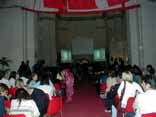  A subject is inducted into a deep state of hypnotic trance. Various tests and deepening procedures are applied that demonstrate the extreme level of hypnotic immersion both to the subject and to the audience. 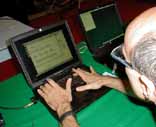 These astonishing tests include a rapid standing induction, levitation of limbs and catalepsy (the body becomes extremely rigid).  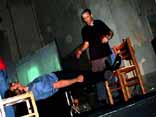 The subject is then introduced in trance into a navigable virtual landscape encased in a flexible structure through which the subject travels. The landscape itself is in flux and reconfigures itself as the journey progresses. The landscape is a configuration of solids and liquids derived from sounds of inductive voices, and upon approaching different areas inductive commands are triggered. The audience is able to follow the immersive journey on a large overhead screen. 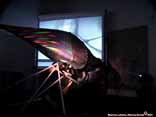  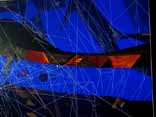 Each time this is performed, both the trajectory and the outcome are different, as these are reconfigured by the intersection of the ever varying eductive-scape with the autonomic nervous system's responses to the changing environment ...as a feedback loop between mental processes and a 3-D suggestive landscape. An eversive process takes place from Psychological to Digital to Analog to Kinesthetic and back around. |
MARCOS
LUTYENS: Hypnosis as used, for instance, in the Krasner method of hypnotherapy
is a vehicle for accessing various aspects and areas of the subconscious
mind and implanting certain ideas through suggestion. The sphere of
action usually takes place within rarely visited but nevertheless familiar
areas of memory and experience and involves transformative mental processes,
also known as individuation or reframing. Eduction, on the contrary,
uses hypnosis as a tool for opening up the territory “without” or beyond
our conception of mind, and uses the subsequent experiences of volunteers
as a feedback mechanism for “fleshing out” and modelling an externalized
virtual space. If individuation is conceived of as the reintegration
of differentiated consciousness within the unconscious, then Eduction
is the nesting of both the conscious and the unconscious within
an expanding and dynamic space of mind. In the opening excerpt of the hypnotic induction used for the performance (see top), you'll notice how even before I started to work with the imagined space between the volunteers' hands, I had already drawn the entire audience's attention to the seats they were sitting on. To alter a state of consciousness, it is necessary to begin to remodel what Joseph Von Uexkül referred to as the umwelt, the self-world, a kind of invisible bubble surrounding living organisms, that is delimited by each organism's particular sensory percepts. By drawing people's attention to their immediate self-world in the forms of touch, propioception and kinesthetics, we are beginning to reduce or enclose the bubble to the geography of reach. |
|||
| Of
course, as I act on the volunteers, their state of consciousness begins
to diverge from the rest of the audience, as, in effect, I begin to
push or sculpt their self-worlds inwards, opening up an interior architecture
of mind, linked to the inner senses and the autonomous nervous system. The engineering of this induction was built around a nest of symmetries: the exterior symmetry of the ancient church, divided by the nave, up and down which I walked, the mirroring of hands separated by an empty space between, the exterior and interior umwelt, delimited by the boundary of the body, and the inner symmetry of the mind in the form of the two hemispheres and what Jung referred to as the quaternity. This framework of symmetries was a vehicle to move the volunteers into a state of deep trance. 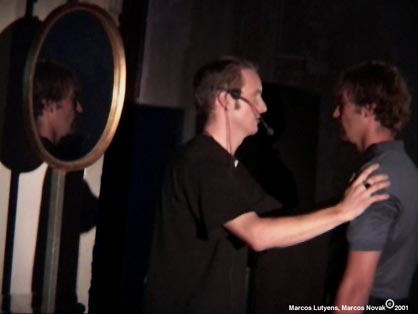 EDUCTION: The Alien Within (by Marcos Lutyens and Marcos Novak). After this initial phase, we worked on detaching the mind from its familiar co-ordinates by establishing automatic responses between aural stimuli and propioceptive responses (the sensors), and reattaching the mind to an inanimate element (catalepsy). The final precondition for entry into the “Eductive” state was a stacking of suggestions related to amnesia and agnosia leading to the loss of self recognition, in other words the dissolution of the mirrored architecture of the self, and its substitution by automatic and unconscious core states. |
||||
| MARIALUISA
PALUMBO: Human perception of and relation to the physical space, at
least in western culture, is deeply rooted in the sense of vision. But,
in a way, the new technologies of vision repeatedly force us to question
what is the meaning of seeing. From this point of view, the reflection
about different dimensions remind us that to see an object –or a space-
means to build a sort of imaginary shape or an ideal object within the
mind. From the two dimensional images of the world on our retina that
we are able to interpret as three dimensional, to the 2D configurations
of lines we use to draw 3D objects, we have a special ability to 'see
in depth'... but, by analogy, we can also imagine a three dimensional
retina able to see 4D shapes and so on... which reveals the presence
of a sort of gap between vision and reality, again an in-between state
or space open to our investigation... |
WORDSCAPES http://imsc.usc.edu WordScape is a haptic environment that allows blind and multi-disabled children to touch and feel their own words and other familiar sounds as three-dimensional objects in space. This will be both an entertaining and educational tool for visually impaired children, as words, noises and sounds are rendered as three-dimensional forms that can be explored and played with by means of haptic devices -such as the Phantom, the CyberGrasp or the Haptic Desk-, connected to microphones and voice processing programs that together create a fully interactive environment.  For the visually impaired who cannot use their eyes to situate themselves in their surroundings, touch and hearing become the main means of connection to the outside world. Sounds become the lynch–pin around which a scene is deciphered, and descriptive words often substitute for solid objects that are out of reach. So, in a sense, words and sounds begin to have a volume and a mass, as their interpretation and meaning substitute for visual experience. 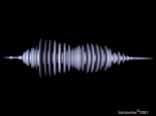 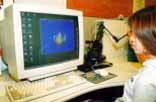  The project is based on the development of a system for creating 3D volumes “on-the-fly” from spectograms of spoken utterances, based on the three-dimensional plot of time, frequency (pitch) and amplitude (volume). 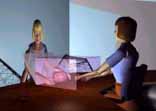 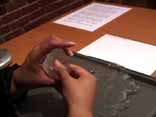 |
|||
| MARCOS
LUTYENS: Experiments comparing hypnosis with ordinary states of consciousness
show that the same parts of the cortex respond in exactly the same computational
pattern to a hallucinated experience as to a real experience. What is
tantalizing is to be able to exercise the cortex in such a way that
states of experience and being which would otherwise literally be inconceivable,
become familiar. This exercise or process, almost akin to a mental vaccine,
may take effect within a hallucinatory state of hypnotic trance. In
this state, the mind becomes completely familiar with the new simulated
territory, whether this is an extra set of limbs as in Stelarc's third
hand, hyper-extended web consciousness, or a visceral conception of
polydimensionality, and so when the subject is returned to a normal
state of consciousness, she is psychologically enabled to handle the
added scope of consciousness, and is not as likely to provoke an unconscious
rejection of the extra sense, organ or limb.. This I believe has relevant
applicability to the psychological “naturalization” of alien extensions
to the human body and mind, in terms of implanted chips pioneered by
Warwick, electronic prosthetic smart- limbs such as the C-Leg, and neural
ports that allow our minds to connect directly to artificial intelligence
networks, all of which lie beyond the familiar parameters of space,
time and body. |
||||
| EMOGENS: The Self at Large http://www.postartum.org Emogens aims to find a corresponding series of patterns that bridge the emotive gap between the individual and the larger global body. It starts off as a laboratory/research project in which hundreds of volunteers are inducted through hypnosis into a state corresponding to the Massive Global Organism. Volunteers draw, sculpt and write their visualizations while in a state of trance. 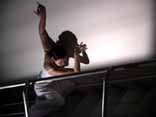 A navigable 3-D world has been generated that is composed of the 'metatypes', or inner mental patterns, extrected through sessions of hypnosis. This 3-D world, toghether with spatialized sound recorded in these trance sessions is exhibited has a full scale, interactive wall-projections.  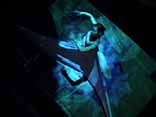 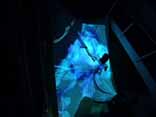 The project proposes bringing these individually-generated forms together into structures that reflect a collective response to the global body. Emogens at Postartum included a performance by a Butoh-trained dancer, Asako Tsunoda, who at first was motivated by trance-induced inner-imagery linking building, mind and global notions, and as she reached the virtual world on the bottom floor of the 3 storey space, her moves were influenced and guided by the 3-D world. The virtual world was navigated in real-time by a volunteer who was also in a trance state. 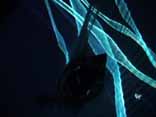 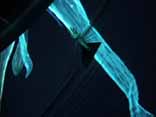 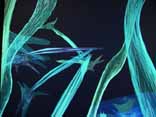 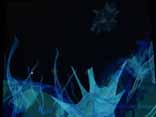 |
MARIALUISA
PALUMBO: In a previous project you have been working with blind children,
trying to explore possible ways to allow them to have a 'physical' experience
of words, a haptic sensation to give body to sounds... When one thinks
about how, for people able to see, closing our eyes is like the first
step to going inside, in your experience did you have any feelings about
the different relation between real and mental spaces in blind people? MARCOS LUTYENS: The mental space for a blind person, as generated by their umwelt is completely different from that of a seeing person. The perceptual bubble moves around predominantly to their auditory sense, which to a certain point substitutes for the lack of visual cues. In the same way, the collapse of the exterior visual space seems to be compensated for by an amplified interior world that is then projected back out into the unseen real world. In a sense, blind people are experts at reversing the normal process of perception to conception, back outwards in a reverse vector, or as Marcos Novak would say, as an “eversion.” Wordscapes, a collaborative project with the University of Southern California and the Foundation for the Junior Blind, becomes an intermediate platform between the interior world of the blind person, built by cues of sound and speech -coincidentally the primary two tools in hypnosis- and the outside world of solid objects. By making words and sounds solid to the touch (remaining curiously invisible to seeing people), we form a bridge between the blind person's interior and the exterior world that is beyond reach. The use of the kinaesthetic sense of touch is particularly important as most blind people suffer from what is termed 'tactile defensiveness,' that is, a resistance to exploration by touch. Of particular interest is extracting a digital/mental phrase or word enunciated by the blind person, breaking down the words into phonemes and sounds, and converting these into analogue equivalents of form and texture. In other words, we move back from semantics to phonology, and syntax to protosyntax to gesture. Again, this trajectory of turning a mental conception into a profoundly experienced albeit modified reality is parallel to the process of Eduction within the context of deep virtuality. Marcos Novak contributed to this project by writing the program that translates the speech into these 3-D haptic forms. |
|||
| MARIALUISA
PALUMBO: What about your last project: Emogens: the self at large?
You are working again around the mapping of consciousness within the
context of deep trance... this time, looking at the new webness we are
living in... MARCOS LUTYENS: This project is an offshoot of Eduction. The idea behind Emogens: the self at large is to find a dynamic correspondence between micro-consciousness and the term coined by Derrick de Kerckhove, 'webness'. The project seeks to establish a series of traits that form a key or bridge between the individual and the vital, interlinked mass of global intercommunication and exchange. The word “emogens” is a merging of the word 'emotion' and the root word 'gene' (gene-sis, gene-tics, re-gene-ration) which together imply the evolution of a new kind of growth, one that ties into ideas of fitness, feedback and mutation, embedded within the extended nervous system and manifested at the primary level of the emotions. The forms that are extracted from volunteers who submit to a 15 minute pre-recorded hypnotic induction could be likened to the axial system of a crystal, which, as it were, pre-forms the crystalline structure in the mother liquid, although it has no material existence of its own. The importance of extracting these forms under a state of trance ties into the Gestalt psychology ideal that phenomenological exploration must be, as Wertheimer said 'undebauched by learning', and biases such as personal values are put aside or 'bracketed' in a state of hypnosis. The current Emogens: the self at large show at Postartum has involved the creation of 2-D and 3-D forms rendered from the subconscious, and followed by questionnaires asking about specific traits of the visualised objects. The 3-D rendering material is silicone based and has the curious property of returning quickly back into its original pleroma-like mass. A live performance involved a Butoh-trained dancer, Asako Tsunoda who descended through the three storey space and on reaching the bottom floor, her dress spread out to form a screen on which was projected a real-time navigable 3-D world controlled by an audience member in trance. She became enmeshed not only in the physical space of the building but also in the psycho-virtual space of 'webness', embodying an exteriorised counterpart to the inwardly experienced worlds of the volunteers.  EMOGENS: The Self at Large. |
||||
| MARIALUISA
PALUMBO: Can we go deeper into this 'webness' concept? Can you just
explain a bit more what is it about, or how do you use it in your induction...
are you looking for traces of an 'extended' consciousness? To make my
question more clear and more focused: you talked about “interlinked
mass of global intercommunication and exchange”, but where is this 'interlinking'
happening... what 'space' are we looking to talking about webness? In
other words, are we talking about a new kind of relationship between
outer and inner space? Or do you see the change into the inner space
just as an effect of an 'outer' or material webness? |
||||
| MARCOS
LUTYENS: There have been many interpretations of 'webness,' and historically
it is an outgrowth of world trade and shipping patterns. This network
of international exchange was one that was largely based on the transfer
of material goods and the movement of people. However, in the last 150
years this network became increasingly more to do with invisible communication
and exchange with the invention of the telegraph and wireless systems
of communication. The network became more to do with intercommunication
and less to do with transfer of goods. A good example of this is the
transfer of money: originally gold had to be shipped physically from
region to region, but this was replaced by the wire transfer. The exchange
became electronic and immaterial, as opposed to molecular and cumbersome.
Of course this network has now turned into the ultimate means of intercommunication
in the form of the World Wide Web. In the Atlas of Cyberspace
(by Martin Dodge and Rob Kitchin) there are many charts and maps that
try to define the 'space' and territory of 'webness', and there is a
heroic attempt to quantify and illustrate the processes of the www.
However, all of these attempts fail to capture the essence of 'webness'
which is more to do with a relationship of 'quality' than 'quantity.'
In short, 'webness' is the new inner-space of the exterior world, very
much equivalent to the inner workings of our own consciousness. When
we try to describe either realm, we find that our descriptions freeze
the picture, and we can only describe a static and partial view. The
challenge of 'webness' is to build a fluid link between the inner space
of mind and the inner space of the web, in the way of a direct feed-back
mechanism between the two, connecting not just information and knowledge,
but emotions and feelings. |
||||
| MARIALUISA
PALUMBO: As a last question, I'd like you to say some more words about
the relationship between space and mind, that is, about the spatial
dimensions of the mind and the mental dimension of space... MARCOS LUTYENS: [Pause... silence... he holds out his hands and stares at the space between...]. |
||||
|
> MARCOS LUTYENS > EDUCTION. DESIGN BY ALGORITHM |
||||